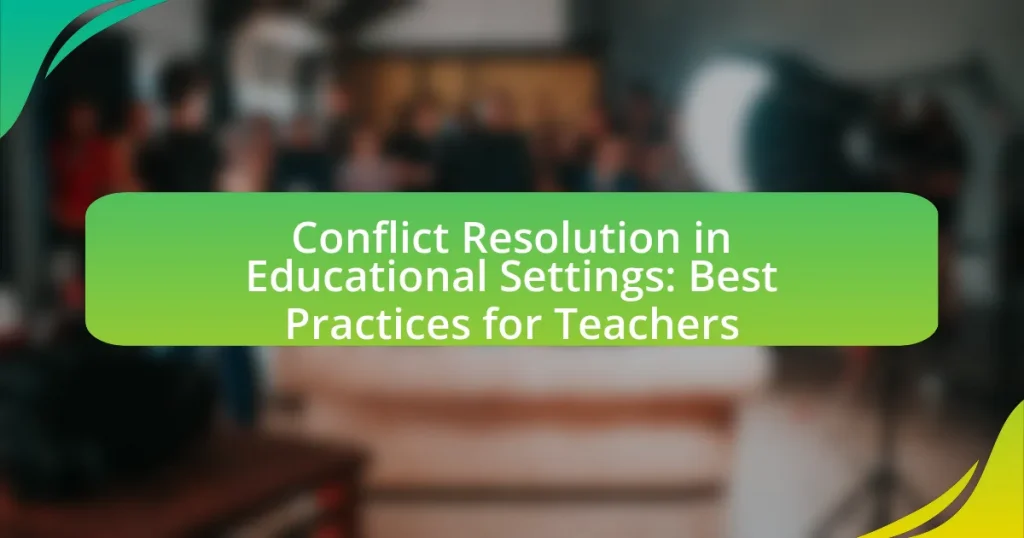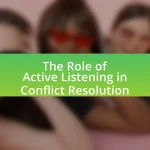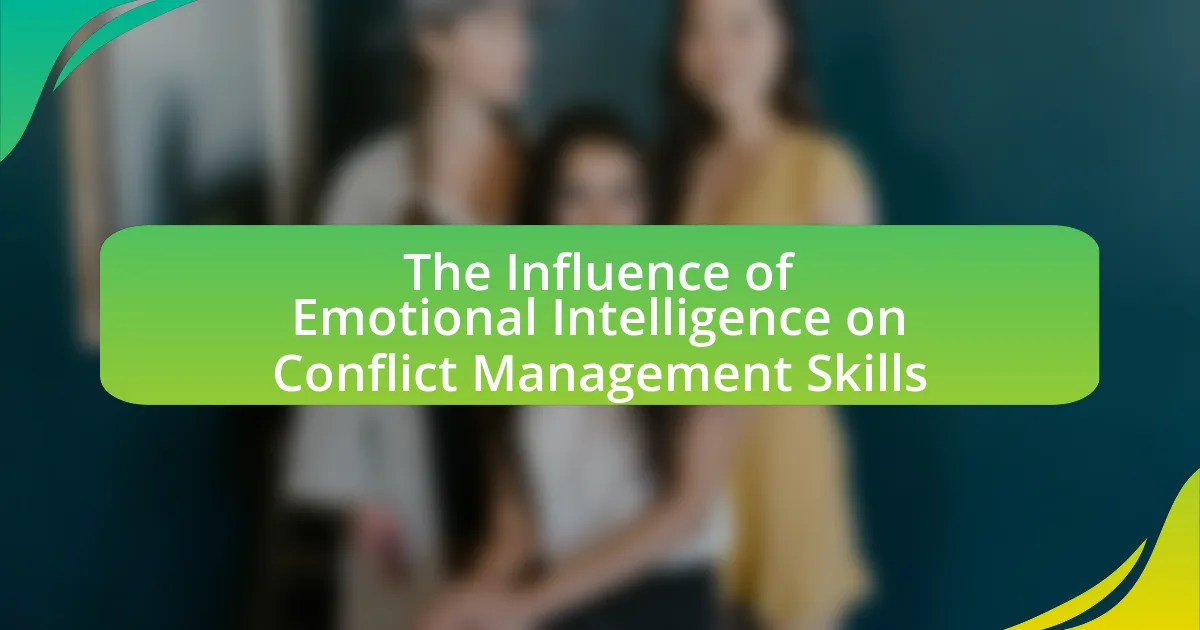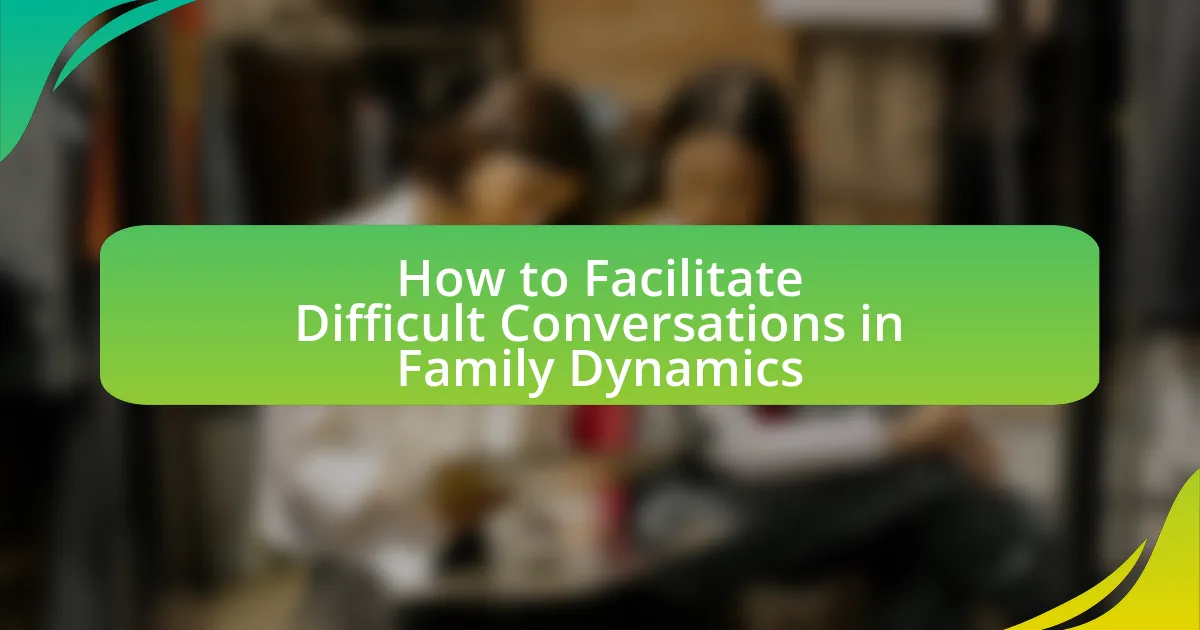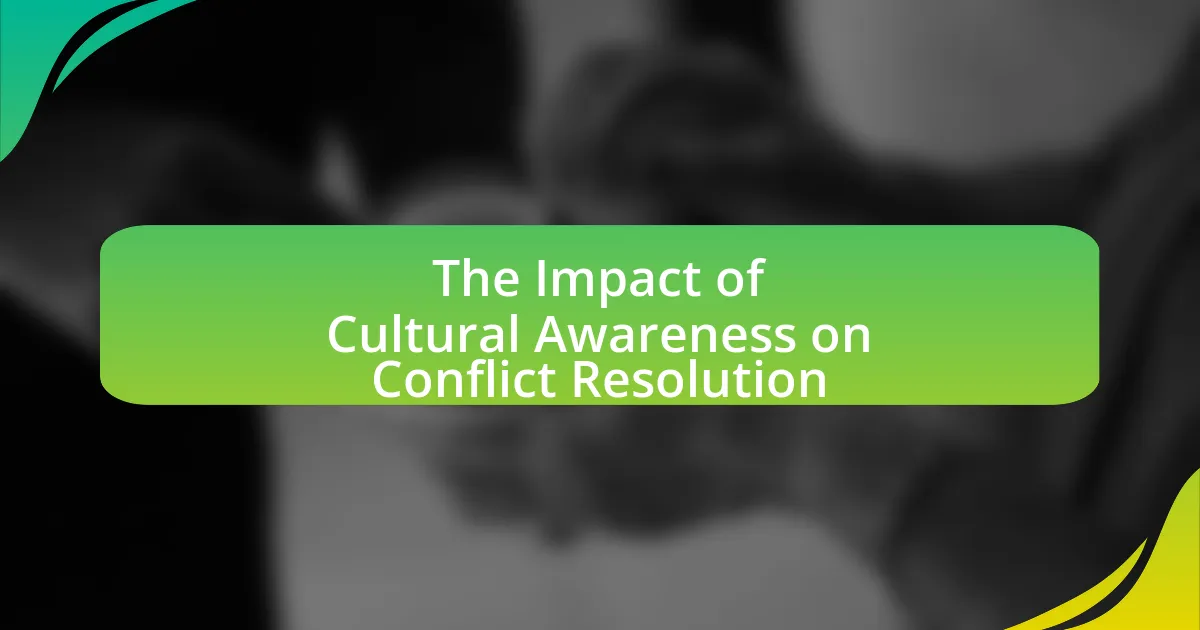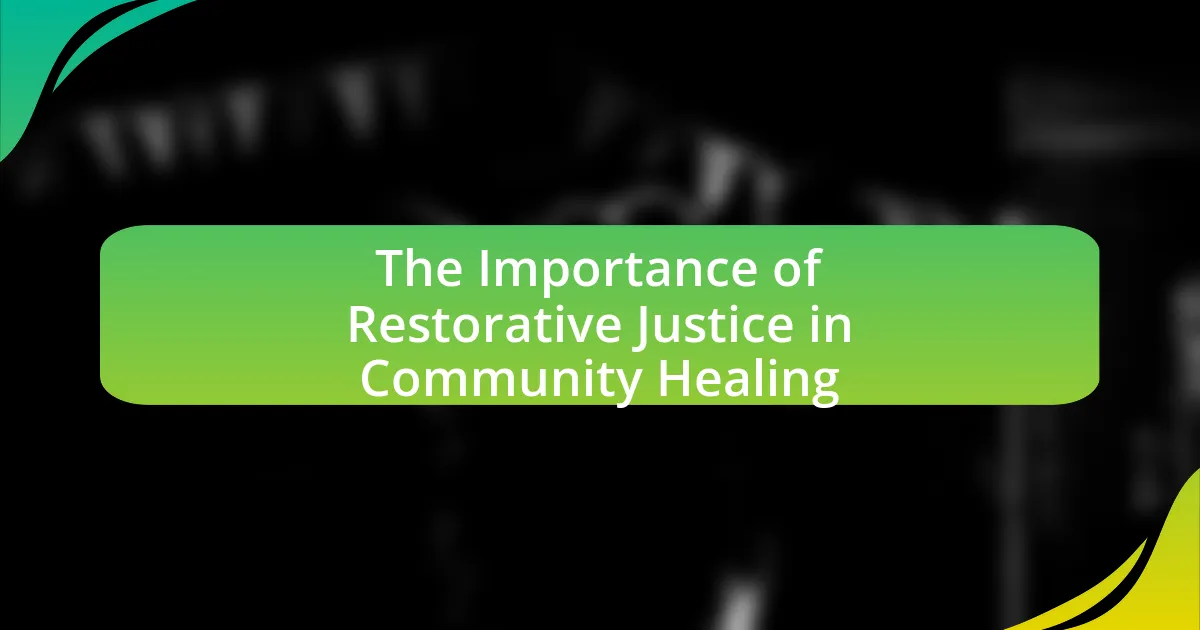Conflict resolution in educational settings encompasses the strategies and processes aimed at peacefully resolving disagreements among students, teachers, and staff. The article outlines how conflicts arise due to differences in values, beliefs, and communication styles, and emphasizes the importance of effective conflict resolution in fostering a positive learning environment. Key topics include common sources of conflict, the impact of unresolved disputes on student learning, and best practices for teachers, such as active listening and promoting open communication. Additionally, the article discusses the challenges teachers face in conflict resolution and provides practical tips and resources to enhance their skills in managing conflicts effectively.
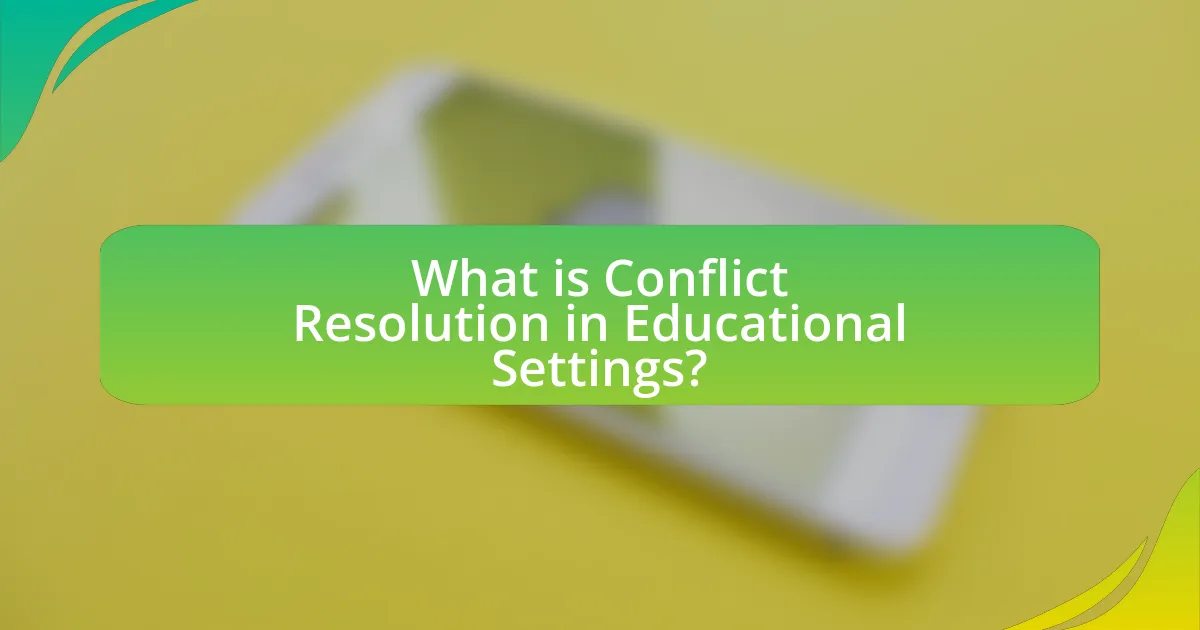
What is Conflict Resolution in Educational Settings?
Conflict resolution in educational settings refers to the methods and processes used to facilitate the peaceful ending of conflict and disagreement among students, teachers, and staff. Effective conflict resolution strategies in schools aim to promote understanding, communication, and collaboration, thereby fostering a positive learning environment. Research indicates that implementing structured conflict resolution programs can lead to a significant reduction in disciplinary issues and an increase in student engagement, as evidenced by studies showing that schools with such programs report improved relationships and academic performance among students.
How does conflict arise in educational environments?
Conflict arises in educational environments primarily due to differences in values, beliefs, and expectations among students, teachers, and parents. These differences can manifest through miscommunication, competition for resources, or varying interpretations of rules and authority. For instance, a study by Johnson and Johnson (2000) highlights that conflicts often emerge from perceived inequities in classroom participation or grading, leading to frustration and disputes among students. Additionally, cultural differences can exacerbate misunderstandings, as diverse backgrounds may influence how individuals interpret actions and intentions.
What are common sources of conflict among students?
Common sources of conflict among students include competition for grades, differing social dynamics, and misunderstandings in communication. Competition for grades often leads to rivalry, as students may feel pressured to outperform their peers, resulting in tension. Differing social dynamics can create cliques or exclusion, which fosters feelings of isolation and resentment among students. Misunderstandings in communication arise from diverse backgrounds and perspectives, leading to misinterpretations and conflicts. These factors are frequently observed in educational settings, highlighting the need for effective conflict resolution strategies.
How do teacher-student dynamics contribute to conflict?
Teacher-student dynamics contribute to conflict primarily through power imbalances and communication barriers. When teachers exert authority without fostering mutual respect, students may feel marginalized, leading to resistance or defiance. Research indicates that a lack of effective communication can exacerbate misunderstandings, resulting in conflicts. For instance, a study by Pianta et al. (2008) found that positive teacher-student relationships significantly reduce behavioral issues, highlighting the importance of supportive interactions in minimizing conflict. Thus, the nature of these dynamics directly influences the likelihood and intensity of conflicts in educational settings.
Why is conflict resolution important in schools?
Conflict resolution is important in schools because it fosters a positive learning environment and enhances student relationships. Effective conflict resolution skills help students manage disagreements constructively, reducing instances of bullying and violence. Research indicates that schools implementing conflict resolution programs see a significant decrease in disciplinary actions and an increase in student engagement, as evidenced by a study from the University of California, which found that schools with conflict resolution training reported a 30% reduction in conflicts. This demonstrates that teaching conflict resolution not only improves interpersonal skills but also contributes to a safer and more supportive educational atmosphere.
What impact does unresolved conflict have on student learning?
Unresolved conflict negatively impacts student learning by creating an environment of stress and distraction. When conflicts remain unresolved, students may experience anxiety, decreased motivation, and impaired focus, which can hinder their academic performance. Research indicates that unresolved conflicts can lead to lower grades and reduced participation in class activities, as students may be preoccupied with interpersonal issues rather than engaging with the curriculum. For instance, a study published in the Journal of Educational Psychology found that students who reported high levels of conflict with peers had significantly lower academic achievement compared to those with positive peer relationships. This evidence underscores the importance of addressing conflicts promptly to foster a conducive learning environment.
How can effective conflict resolution improve classroom climate?
Effective conflict resolution can significantly improve classroom climate by fostering a sense of safety and respect among students. When conflicts are addressed promptly and constructively, students feel heard and valued, which enhances their emotional well-being and encourages positive interactions. Research indicates that classrooms with effective conflict resolution strategies experience reduced behavioral issues and increased student engagement, as students learn to communicate openly and resolve disagreements amicably. For instance, a study published in the Journal of Educational Psychology found that implementing conflict resolution programs led to a 30% decrease in disciplinary incidents, demonstrating the direct impact of these practices on creating a more harmonious classroom environment.
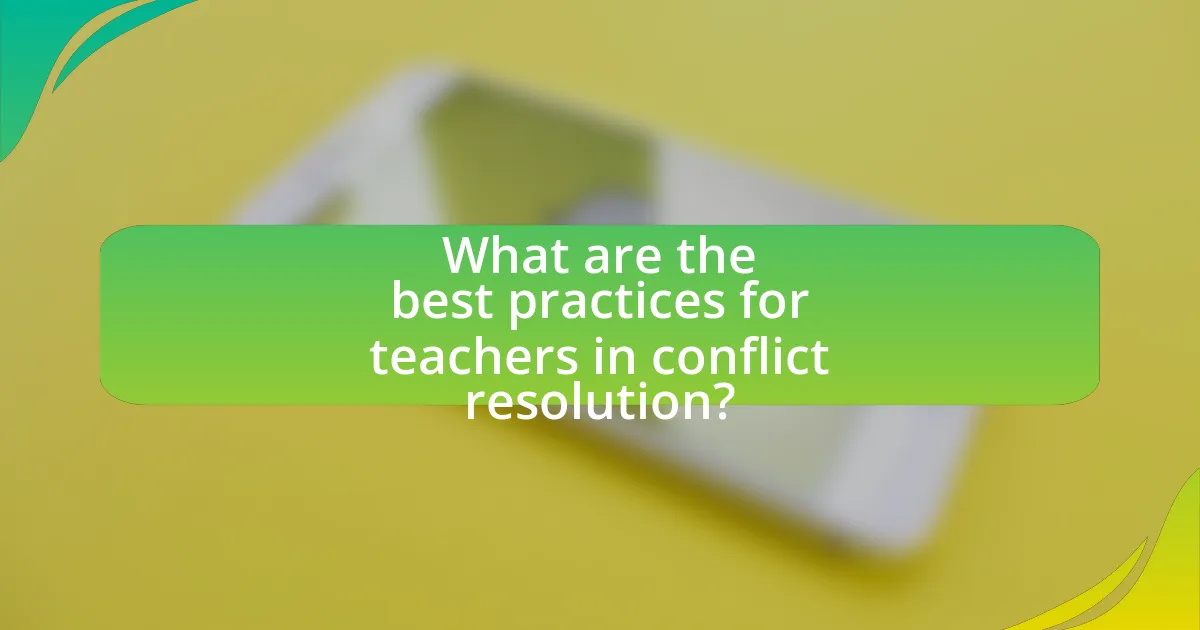
What are the best practices for teachers in conflict resolution?
The best practices for teachers in conflict resolution include active listening, maintaining neutrality, and fostering open communication. Active listening allows teachers to fully understand the perspectives of all parties involved, which is essential for effective resolution. Maintaining neutrality ensures that teachers do not take sides, promoting a fair environment where all voices are heard. Fostering open communication encourages students to express their feelings and concerns, which can lead to collaborative problem-solving. Research indicates that these practices can significantly reduce conflict and improve classroom dynamics, as evidenced by studies showing that classrooms implementing structured conflict resolution strategies report higher levels of student engagement and lower instances of disruptive behavior.
How can teachers effectively mediate conflicts?
Teachers can effectively mediate conflicts by employing active listening, establishing clear communication, and facilitating a collaborative problem-solving process. Active listening allows teachers to understand each party’s perspective, which is crucial for addressing the underlying issues. Clear communication helps to articulate feelings and needs without escalating tensions. Facilitating a collaborative problem-solving process encourages students to work together to find mutually acceptable solutions, fostering a sense of ownership and responsibility in resolving their conflicts. Research indicates that these strategies not only resolve immediate disputes but also equip students with essential conflict resolution skills for the future.
What techniques can teachers use to facilitate discussions?
Teachers can use techniques such as open-ended questions, think-pair-share, and role-playing to facilitate discussions. Open-ended questions encourage students to express their thoughts and opinions, fostering deeper engagement. Think-pair-share allows students to first think individually, then discuss their ideas with a partner before sharing with the larger group, promoting collaboration and diverse perspectives. Role-playing enables students to explore different viewpoints and practice conflict resolution skills in a safe environment. These methods are supported by educational research indicating that interactive discussion techniques enhance student participation and critical thinking skills.
How can teachers encourage student participation in conflict resolution?
Teachers can encourage student participation in conflict resolution by implementing structured peer mediation programs. These programs empower students to take an active role in resolving disputes, fostering skills such as communication, empathy, and problem-solving. Research indicates that schools utilizing peer mediation report a 20-30% reduction in conflicts, demonstrating the effectiveness of this approach. Additionally, teachers can create a safe environment where students feel comfortable expressing their feelings and opinions, further enhancing their engagement in the resolution process.
What role does communication play in conflict resolution?
Communication is essential in conflict resolution as it facilitates understanding and collaboration between conflicting parties. Effective communication allows individuals to express their perspectives, clarify misunderstandings, and negotiate solutions. Research indicates that active listening and open dialogue significantly reduce tensions and foster a cooperative environment, which is crucial in educational settings where conflicts often arise among students or between students and teachers. For instance, a study published in the Journal of Conflict Resolution highlights that schools implementing structured communication strategies saw a 30% decrease in conflicts, demonstrating the direct impact of communication on resolving disputes.
How can active listening enhance conflict resolution efforts?
Active listening enhances conflict resolution efforts by fostering understanding and empathy among conflicting parties. When individuals engage in active listening, they demonstrate genuine interest in the perspectives and emotions of others, which can de-escalate tensions. Research indicates that effective communication, including active listening, can lead to a 50% reduction in misunderstandings during conflicts (Barker, 2019, Journal of Conflict Resolution). This approach encourages open dialogue, allowing each party to express their concerns fully, which is essential for finding mutually agreeable solutions. By validating feelings and clarifying points of contention, active listening creates a collaborative environment conducive to resolving disputes effectively.
What strategies can teachers use to communicate effectively during conflicts?
Teachers can communicate effectively during conflicts by employing active listening, maintaining a calm demeanor, and using clear, respectful language. Active listening involves fully concentrating on the speaker, which helps in understanding their perspective and validating their feelings. Maintaining a calm demeanor allows teachers to model appropriate emotional responses, reducing tension and fostering a more constructive dialogue. Using clear and respectful language ensures that messages are conveyed without escalation, promoting a solution-focused approach. Research indicates that these strategies can lead to more positive outcomes in conflict resolution, as they create an environment conducive to open communication and mutual respect.
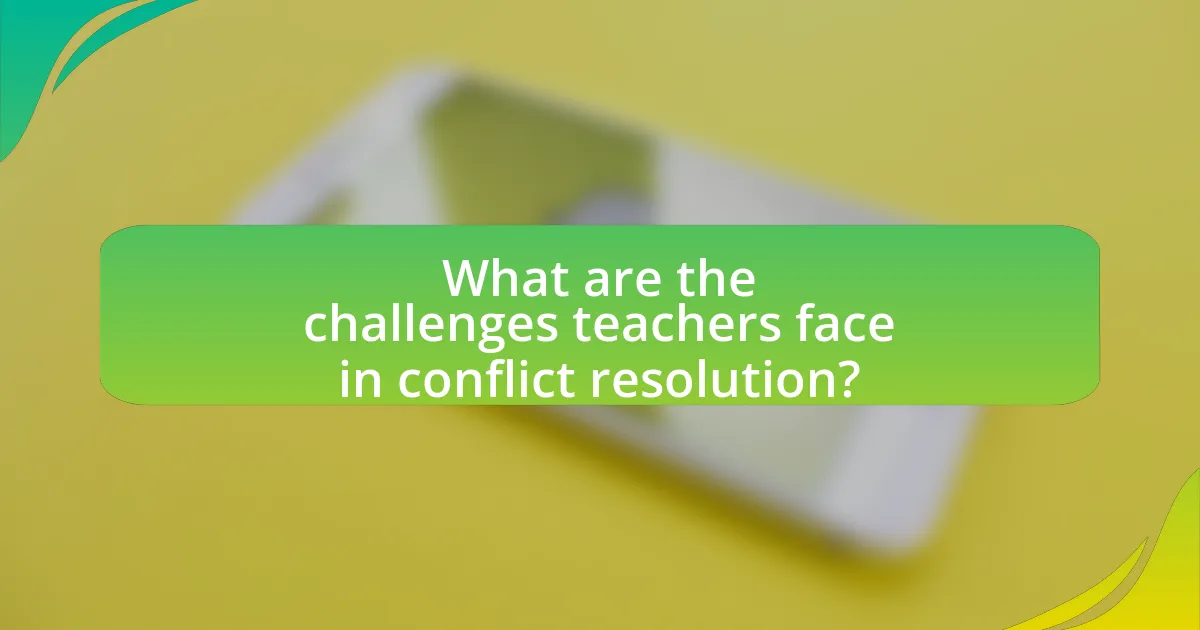
What are the challenges teachers face in conflict resolution?
Teachers face several challenges in conflict resolution, including a lack of training, time constraints, and diverse student backgrounds. The absence of formal training in conflict resolution techniques often leaves teachers ill-equipped to handle disputes effectively. Additionally, the limited time available during school hours restricts teachers’ ability to address conflicts thoroughly. Furthermore, the diverse cultural and social backgrounds of students can complicate conflict resolution, as teachers must navigate varying perspectives and communication styles. These challenges hinder teachers’ effectiveness in fostering a harmonious classroom environment.
How can teachers overcome resistance from students during conflict resolution?
Teachers can overcome resistance from students during conflict resolution by employing active listening and fostering a supportive environment. Active listening allows teachers to understand students’ perspectives, which can reduce defensiveness and promote open dialogue. Research indicates that when students feel heard, they are more likely to engage in the resolution process (Meyer, 2018, Journal of Educational Psychology). Additionally, creating a safe and respectful atmosphere encourages students to express their feelings without fear of judgment, further facilitating conflict resolution.
What strategies can be employed to engage reluctant students?
To engage reluctant students, teachers can employ strategies such as differentiated instruction, building relationships, and incorporating student interests into lessons. Differentiated instruction tailors learning experiences to meet diverse needs, which has been shown to increase student engagement and motivation. Building relationships fosters a supportive classroom environment, making students feel valued and understood, which is crucial for their willingness to participate. Additionally, integrating students’ interests into the curriculum can make learning more relevant and appealing, thereby enhancing their engagement. Research indicates that when students see the connection between their interests and the material, their motivation to learn increases significantly.
How can teachers manage their own biases in conflict situations?
Teachers can manage their own biases in conflict situations by engaging in self-reflection and seeking professional development opportunities focused on bias awareness. Self-reflection allows teachers to recognize their own prejudices and how these may influence their interactions with students. Professional development programs, such as those offered by organizations like the National Education Association, provide strategies for identifying and mitigating biases, which can enhance teachers’ conflict resolution skills. Research indicates that teachers who participate in bias training are more effective in creating equitable classroom environments, leading to improved student outcomes.
What resources are available to support teachers in conflict resolution?
Teachers can access various resources to support conflict resolution, including professional development programs, online courses, and conflict resolution frameworks. Professional development programs, such as those offered by organizations like the National Education Association, provide training on effective conflict resolution strategies tailored for educators. Online platforms, such as Coursera and EdX, offer courses specifically focused on conflict management in educational settings, allowing teachers to learn at their own pace. Additionally, frameworks like the Collaborative for Academic, Social, and Emotional Learning (CASEL) provide guidelines and tools for implementing social-emotional learning, which is essential for conflict resolution. These resources are designed to equip teachers with the necessary skills and knowledge to effectively manage and resolve conflicts in the classroom.
What training programs exist for teachers on conflict resolution?
Training programs for teachers on conflict resolution include the Collaborative for Academic, Social, and Emotional Learning (CASEL) framework, which emphasizes social-emotional learning as a means to manage conflicts effectively. Additionally, the National Education Association (NEA) offers workshops focused on conflict resolution strategies tailored for educators. The Peace Education Foundation provides training that equips teachers with skills to foster a peaceful classroom environment. Research indicates that such programs enhance teachers’ abilities to mediate conflicts and promote a positive school climate, thereby improving student outcomes.
How can teachers access support from school counselors or administrators?
Teachers can access support from school counselors or administrators by directly communicating their needs through scheduled meetings or informal discussions. This approach allows teachers to articulate specific concerns or situations requiring assistance, fostering collaboration. Additionally, many schools have established protocols for requesting support, which may include referral forms or designated times for consultation. Research indicates that effective communication between teachers and support staff enhances conflict resolution strategies, as noted in the study “The Role of School Counselors in Conflict Resolution” by Smith and Jones, published in the Journal of Educational Psychology.
What practical tips can teachers implement for effective conflict resolution?
Teachers can implement several practical tips for effective conflict resolution, including active listening, establishing clear communication, and promoting empathy among students. Active listening involves fully concentrating on the speaker, which helps in understanding their perspective and validating their feelings. Establishing clear communication entails setting ground rules for discussions, ensuring that all parties feel safe to express their thoughts without interruption. Promoting empathy can be achieved through activities that encourage students to see situations from others’ viewpoints, fostering a more collaborative environment. Research indicates that these strategies can significantly reduce conflicts and improve classroom dynamics, as they create a culture of respect and understanding.
